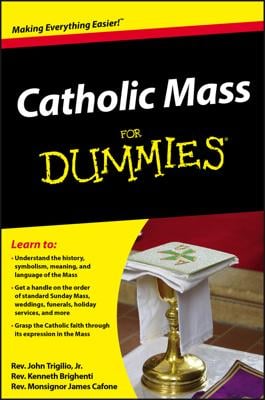The Mass incorporates the Bible (Sacred Scripture), prayer, sacrifice, hymns, symbols, gestures, sacred food for the soul, and directions on how to live a Catholic life — all in one ceremony.
The first part of the Mass in the Western (Latin) Church is the Liturgy of the Word, and its main focus is on Bible readings as an integral part of daily and weekly worship. The second part is the Liturgy of the Eucharist, and its main focus is the holiest and most sacred part of the Mass — Holy Eucharist.
Eastern Rite Catholics call their Mass the Divine Liturgy, but it’s essentially the same. Eastern Catholics also use the two-fold division of Liturgy of the Catechumens and Liturgy of the Faithful, which coincide with the Liturgy of the Word and the Liturgy of the Eucharist. The differences are merely from the fact that in the West, the Mass follows the tradition of the Roman liturgy, but in the East, it’s the liturgical tradition of Constantinople.
The Liturgy of the Word
The first part of the Mass is built around hearing the word of God. After the priest and his attendants process to the altar, the priest and congregation participate in the Penitential Rite, which is simply an acknowledgement that everyone is a sinner and has sinned to some degree during the week. This Confiteor is followed by the kyrie, which expresses public guilt and shame for any sins against God.The Gloria, a prayer or hymn of adoration of God, is followed by a prayer that addresses all three persons of the Holy Trinity, and that usually sets the tone for the rest of the prayers and Bible readings at Mass. Every day has its own unique prayers and readings chosen by the Church, not the individual parish.
A qualified lector then reads the designated passages of the day. Following these readings, the congregation, which has been sitting, stands while the priest or deacon reads the holy Gospel, which contain the very words and deeds of Christ and require the respect shown by standing.
The congregation sits and listens to the homily, which is different than a sermon in that it’s an explanation and reflection on the Word of God read only by clergy. The priest or deacon connects the Scripture readings to the daily lives of the people, the teachings of the Church, or the particular celebration at hand.
On Sundays and holy days, the homily is followed by the Profession of Faith, or Creed, which succinctly sums up all the teachings of the Church. Then comes the Prayers of the Faithful, which are petitions are for the pope, the Church, the civil authorities, current concerns, and so on, to which the people respond with “Lord, hear our prayer” or “Hear us, O Lord.”
The Liturgy of the Eucharist
As the Liturgy of the Eucharist begins, everyone sits down and baskets are passed to collect monetary offerings. These are then brought to the altar along with a cruet of plain drinking water, a cruet of grape wine, and a container of unconsecrated hosts during the offertory.The deacon or priest pours wine into the chalice and adds a few drops of water to symbolize the union of the divinity and humanity of Christ. The priest lifts the hosts above the altar as an offering to God, then does the same with the wine-filled chalice. The priest then ceremonially washes his hands as priests and rabbis did before ritual slaughters. It’s a reenactment of the real sacrifice of Jesus.
After the Sanctus (Latin for Holy) is prayed, or, more often sung, the congregation kneels for the first time for the holiest part of the Mass, the Consecration. Catholicism professes that when the priest consecrates the bread and wine, it becomes the body and blood of Christ in the miracle of transubstantiation. It still looks, feels, and tastes like bread and wine, but it’s not.
The ringing of bells at the Consecration signifies the holiest moment of the Mass, a symbol of reverent rejoicing. Often, bells are rung when the priest elevates the Host, and again, when he elevates the chalice.
After the congregation prays the Our Father, the priest or deacon may say “Let us offer each other a sign of peace,” and each parishioner gives those standing next to and near to her a simple handshake to show solidarity as one family of faith before the real and most intimate sign of unity — Holy Communion.The Agnus Dei (Lamb of God), which asks God for mercy and peace, is said or sung, and then the people kneel in prayer before lining up to receive the Holy Eucharist.
The priest first consumes the consecrated Host and then drinks the consecrated wine from the chalice. Then Catholics who are in a state of grace approach the priest, deacon or extraordinary minister and are given a consecrated Host. Sometimes, they’re also offered a sip of the Precious Blood (the consecrated wine) from the cup. Before actually receiving Holy Communion, a Catholic makes some sign of reverence — a bow of the head, the sign of the cross, a genuflection, kneeling, and so on.
When presenting the consecrated Host, the priest, deacon or extraordinary minister says “the Body of Christ” to which the recipient replies “Amen,” signifying, “Yes, I do believe it is Jesus.” If the Precious Blood is offered, the communicant may go to the person holding it who says, “the Blood of Christ,” and she replies again, “Amen.” Then she takes the cup and drinks a few sips of the consecrated wine and hands the cup back.
After receiving Holy Communion, the faithful go back to their pews and pray silently for a few minutes before sitting down.
The Mass ends with the priest blessing the congregation and sending them forth to spread the Word of God and put it into practice.

